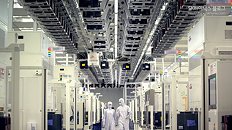Raevenlord
News Editor
- Joined
- Aug 12, 2016
- Messages
- 3,755 (1.25/day)
- Location
- Portugal
| System Name | The Ryzening |
|---|---|
| Processor | AMD Ryzen 9 5900X |
| Motherboard | MSI X570 MAG TOMAHAWK |
| Cooling | Lian Li Galahad 360mm AIO |
| Memory | 32 GB G.Skill Trident Z F4-3733 (4x 8 GB) |
| Video Card(s) | Gigabyte RTX 3070 Ti |
| Storage | Boot: Transcend MTE220S 2TB, Kintson A2000 1TB, Seagate Firewolf Pro 14 TB |
| Display(s) | Acer Nitro VG270UP (1440p 144 Hz IPS) |
| Case | Lian Li O11DX Dynamic White |
| Audio Device(s) | iFi Audio Zen DAC |
| Power Supply | Seasonic Focus+ 750 W |
| Mouse | Cooler Master Masterkeys Lite L |
| Keyboard | Cooler Master Masterkeys Lite L |
| Software | Windows 10 x64 |
DRAMeXchange, a division of TrendForce, has come forward with the expected announcement that DRAM output in 2018 likely won't be enough to fully satisfy supply. This has been the case for some time now. However, what started with simple insufficient output that could contain the explosion of DRAM capacity in smartphones seems to now be turning into a conscious decision by the three top memory manufacturers. Samsung, Micron, and SK Hynix are seemingly setting output at a lower than required level so as to artificially inflate pricing due to low supply. TrendForce themselves say so, in that these suppliers "(...) have opted to slow down their capacity expansions and technology migrations so that they can keep next year's prices at the same high level as during this year's second half. Doing so will also help them to sustain a strong profit margin."
DRAM production is expected to increase by 19,6% in 2018; however, this ratio is lower than the expected growth in demand, which is being pegged at 20,6%. This means 2018 is likely to see increased constraint in the supply channels (whereas 2018 was actually expected to see a slight relief in supply issues). This means that pricing will either stabilize or tend to increase from current levels. To be fair, semiconductor production isn't as simple as hitting a "increase production by 10x" button; reports say that all three players are contending with insufficient room to expand output on their production lines, and getting a new production facility online isn't a trivial effort - neither in funds, nor on time. However... All involved companies would much rather keep prices as they are than see them being brought down by oversupply.


View at TechPowerUp Main Site
DRAM production is expected to increase by 19,6% in 2018; however, this ratio is lower than the expected growth in demand, which is being pegged at 20,6%. This means 2018 is likely to see increased constraint in the supply channels (whereas 2018 was actually expected to see a slight relief in supply issues). This means that pricing will either stabilize or tend to increase from current levels. To be fair, semiconductor production isn't as simple as hitting a "increase production by 10x" button; reports say that all three players are contending with insufficient room to expand output on their production lines, and getting a new production facility online isn't a trivial effort - neither in funds, nor on time. However... All involved companies would much rather keep prices as they are than see them being brought down by oversupply.


View at TechPowerUp Main Site



 ).
). housing crisis "terrible" national deficit ok
housing crisis "terrible" national deficit ok  welcome to America thinking not required Bernie or bust or bankrupt by his wife's bailout money bonus. Oh well thank god we still have RAMBUS to save the day.
welcome to America thinking not required Bernie or bust or bankrupt by his wife's bailout money bonus. Oh well thank god we still have RAMBUS to save the day.
